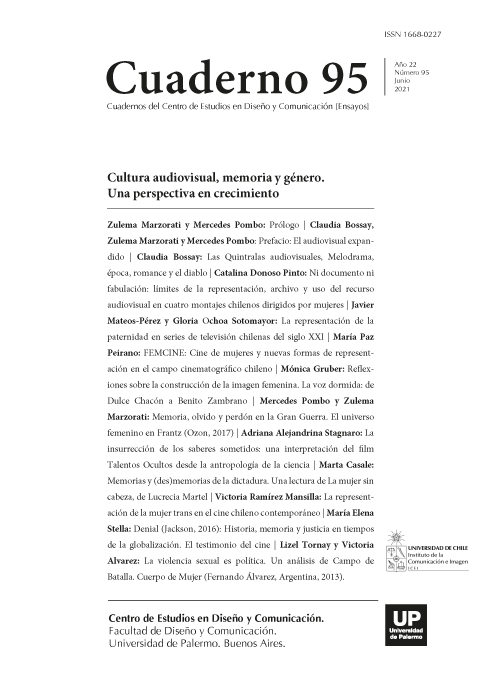Prefacio: El audiovisual expandido
Abstract
This dossier -Cuaderno in Spanish- takes shape as a crossroads between perspectives and reflections on gender in the audiovisual field, and the ways of approaching this problem from contemporary perspectives. This issue has been coordinated by Universidad de Palermo, in Argentina and Universidad de Chile, with the purpose of uniting new voices, thereby enriching the discipline.
The proposal is to explore the role of women in modernity and how the audiovisual field has taken it into account, keeping in mind the tensions and conflicts within the cultural, social, scientific-technological changes, and the relationships that the subjects create with the fields. Women's agency is manifested through political and social organizations as well as through art and culture, fighting for equal rights between the sexes and against patriarchal violence, and for creating representations that make visible the diverse experiences of deconstructed genres.
It is expected that the articles that make up this Cuaderno will awaken reflection through the analysis of the films, television series and other audiovisual culture, not only within aesthetical discourse, but also through social and political discourses that contribute to the configurations of mentalities in modern society, in this case, focused on gender issues as a non-binary spectrum.
References
Burke, P. (2001). Visto y no visto. El uso de la imagen como documento histórico, Crítica: Barcelona.
Burke, P. (2011). “Historia y memorias: un enfoque comparativo”. En Isegoría. Revista de Filosofía, Moral y Política, N°45, Madrid: CSIC, pp. 489-499.
Butler, J. (2007) El género en disputa. El feminismo y la subversión de la identidad. Barcelona: Paidós
Dayan, D. (2000). “Looking for Sundance: The Social Construction of a Film Festival.” Moving Images, Culture and the Mind. Ed. Ib Bondebjerg. Luton: Univ. of Luton Press. pp. 43–52. | Reprinted in The Film Festivals Reader. Ed. Dina Iordanova. St Andrews: St Andrews Film Studies. pp. 45–58.
De Beauvoir, S. (1987). El segundo sexo. Los hechos y los mitos. Buenos Aires: Editorial Siglo Veinte.
Hagedoorn, B. (2013). “Television as a Hybrid Repertoire of Memory. New Dynamic Practices of Cultural Memory in the Multi-Platform Era”. Journal of European Television History and Culture. Volumen 2 Issue 3/2013.
Holdsworth, A. (2011). Television, Memory and Nostalgia. Palgrave Macmillan.
Kompare, D. (2006) Rerun Nation: How Repeats Invented American Television. Routledge.
Mujica, C. (2007). “La telenovela de época chilena: entre la metáfora y el trauma.” En Cuaderno de Información. N°21, pp 20-33.
Nichols, B. (1994). “Global Image Consumption in the Age of Late Capitalism.” East-West Film Journal 8:1 (1994): 68–85.
Nora, P. (1997). “Preface to the English Language Edition” en: The realms of memory. New York: Columbia University Press, pp. XV-XXIV
Rodriguez, M.A. (2002). Histories of México: Personification of the Past in Historical Novels and Historical Soap Operas. Tesis de Doctorado. Universidad de Michigan
Wakeman, J. (1988). World Film Directors, Volume 2., New York: The H. W. Wilson Company
Todorov, T. (2008). Los abusos de la memoria, Buenos Aires: Paidós
Los autores/as que publiquen en esta revista ceden los derechos de autor y de publicación a "Cuadernos del Centro de Estudios de Diseño y Comunicación", Aceptando el registro de su trabajo bajo una licencia de atribución de Creative Commons, que permite a terceros utilizar lo publicado siempre que de el crédito pertinente a los autores y a esta revista.


